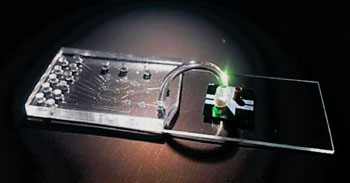Chip-Based Technology Enables Direct Detection of Ebolavirus
By LabMedica International staff writers
Posted on 07 Oct 2015
A hybrid device has been developed that integrates a microfluidic chip for sample preparation and an optofluidic chip for optical detection of individual molecules of viral ribonucleic acid (RNA). Posted on 07 Oct 2015
The current gold standard for Ebolavirus detection relies on a method called polymerase chain reaction (PCR) to amplify the virus's genetic material for detection. Because PCR works on DNA molecules and Ebola is an RNA virus, the reverse transcriptase enzyme is used to make DNA copies of the viral RNA prior to PCR amplification and detection.

Image: This hybrid device integrates a microfluidic chip for sample preparation and an optofluidic chip for optical detection of individual molecules of viral RNA (Photo courtesy of Joshua W. Parks).
Scientists at The University of California, Santa Cruz (CA, USA) have developed chip-based technology for reliable detection of Ebolavirus and other viral pathogens. The system uses direct optical detection of viral molecules and can be integrated into a simple, portable instrument for use in field situations where rapid, accurate detection of Ebola infections is needed to control outbreaks. The system combines two small chips, a microfluidic chip for sample preparation and an optofluidic chip for optical detection.
The microfluidic devise is made of a silicon-based polymer, polydimethylsiloxane (PDMS), and has microvalves and fluidic channels to transport the sample between nodes for various sample preparation steps. The targeted molecules, in this case, Ebolavirus RNA are isolated by binding to a matching sequence of synthetic DNA, called an oligonucleotide, attached to magnetic microbeads. The microbeads are collected with a magnet, nontarget biomolecules are washed off, and the bound targets are then released by heating, labeled with fluorescent markers, and transferred to the optofluidic chip for optical detection.
In laboratory tests, the system provided sensitive detection of Ebolavirus while giving no positive counts in tests with two related viruses, Sudan ebolavirus and Marburgvirus. Testing with different concentrations of Ebolavirus demonstrated accurate quantification of the virus over six orders of magnitude. Adding a "preconcentration" step during sample processing on the microfluidic chip extended the limit of detection well beyond that achieved by other chip-based approaches, covering a range comparable to PCR analysis.
Holger Schmidt, PhD, a professor of Optoelectronics and senior author of the study, said, “Compared to our system, PCR detection is more complex and requires a laboratory setting. We're detecting the nucleic acids directly, and we achieve a comparable limit of detection to PCR and excellent specificity. The measurements were taken at clinical concentrations covering the entire range of what would be seen in an infected person.” The study was published on September 25, 2015, in the journal Nature Scientific Reports.
Related Links:
The University of California, Santa Cruz














